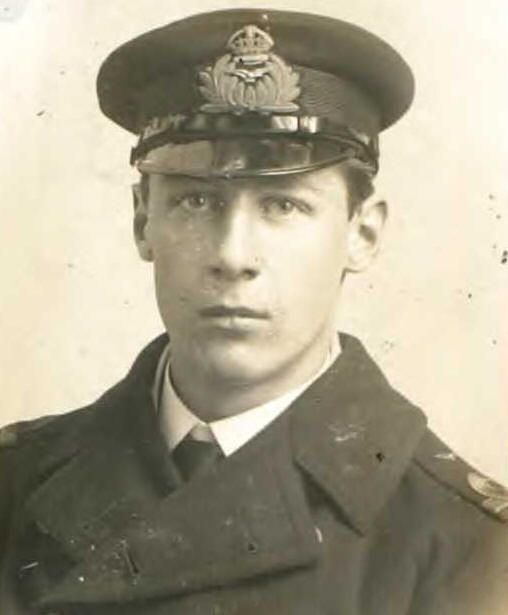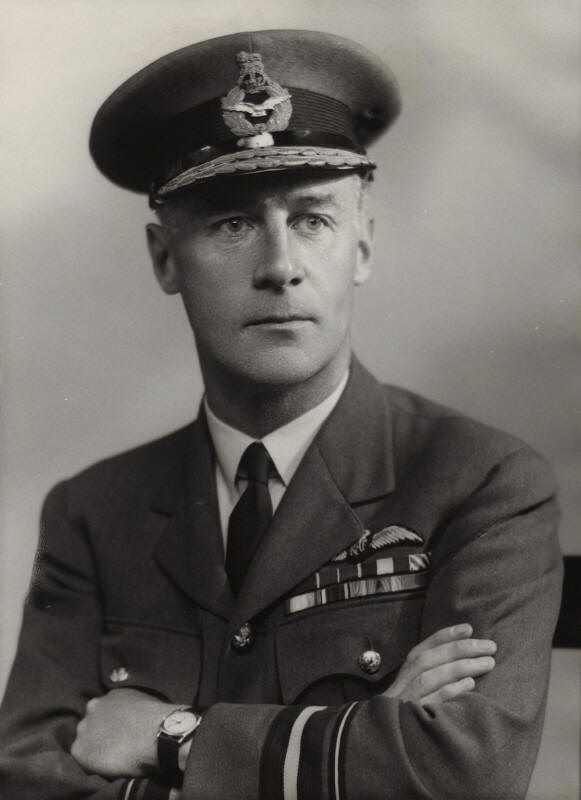bromide print, 25 June 1942
NPG x85402
© National Portrait Gallery, London
Air of Authority - A History of RAF Organisation
Air Marshal Sir Ralph Sorley

 Ralph Squire
b: 9 Jan 1898
r: 6 Sep 1948
d: 17 Nov 1974
Ralph Squire
b: 9 Jan 1898
r: 6 Sep 1948
d: 17 Nov 1974
KCB - 8 Jun 1944 (CB - 11 Jun 1942), OBE - 23 Jun 1936, DSC - 14 Sep 1918, DFC - 28 Oct 1921, LoM (Cdr) - 6 May 1947, FRAeS, FRSA,
1st Prize, 'Gordon-Shephard' Competition - 1935
(RNAS):- (P) Flt Sub-Lt: 4 Dec 1914, Flt Sub-Lt: 30 Apr 1915 [4 Dec 1914], Flt Lt: 1 Jan 1916, Flt Cdr: 31 Dec 1917.
(RAF):- (T) Capt [Lt]: 1 Apr 1918, Fg Off: 27 Nov 1919, Flt Lt: 30 Jun 1921 [1 Apr 1918], Sqn Ldr: 8 Jan 1930, Wg Cdr: 1 Jul 1936, Gp Capt: 1 Jan 1940, Act A/Cdre: xx xxx xxxx, (T) A/Cdre: 1 Jun 1941, Act AVM: 5 Jun 1941, Gp Capt: 14 Apr 1942 [1 Jan 1940], (T) AVM: 1 Dec 1942, A/Cdre: 1 Jun 1943, Act AM: 20 Apr 1943, AVM (WS): 20 Apr 1944, AVM: 1 Jan 1946, (T) AM: 1 Jan 1946, AM: 1 Jul 1947.
Photo (Far left) - taken from his RAeC Certificate
Photo (left) -
© National Portrait Gallery, London
4 Dec 1914: U/T Pilot, RNAS Eastchurch
xx xxx 1915: Pilot, RNAS Calshot
1915 Pilot, HMS Engadine.
1916 Pilot, RNAS Killingholme
xx Jun 1917 Pilot, No 2 Wing, HMS Ark Royal.
1 Jan 1918: Pilot, 'C'/No 220 Sqn.
xx Jul 1918: Flight Commander?, RAF Great Yarmouth
29 Jul
1919: Transferred
to Unemployed List
1 Aug 1919: Awarded Permanent Commission as a Lieutenant
25 Nov 1919: Announcement of Permanent Commission cancelled.
27 Nov 1919. Awarded Short Service Commission as a Flying Officer (from Flt Lt)
13 Feb 1920: Awaiting disposal, HQ Mesopotamian Wing.
xx xxx 1920: Pilot, No 6 Sqn. (Iraq)
21 Apr 1922: Flight Commander, No 14 Sqn. (Palestine)
8 Apr 1924: Staff, Marine Aircraft Experimental Establishment.
4 May 1925: Flight Commander, No 22 Sqn.
1 Mar 1927: Staff, Directorate of Scientific Research and Technical Development.
20 Jan 1930: Attended RAF Staff College.
2 Jan 1931: Officer Commanding, No 8 Sqn.
14 Nov 1932: Posted to Home Establishment
17 Jan 1933: Officer i/c, Operational Requirements Section , Directorate of Ops and Int.
14 Jan 1936: Attended Imperial Defence College.
6 Dec 1937: Officer Commanding, No 4 Armament Training Station - West Freugh.
10 Feb 1939: Supernumerary, HQ No 6 (Auxiliary) Group.
24 Mar 1939: Officer Commanding, RAF Upwood.
8 Sep 1939: Officer Commanding, RAF Abingdon (No 1 Group Pool)
18 Sep 1939: Officer Commanding, RAF Benson (No 1 Group Pool)
21 Sep 1939: Senior Air Staff Officer, HQ No 6 Group
xx xxx 1940: Commandant, A. & A.E.E.
5 Jun 1941: Assistant Chief of the Air Staff (Operational Requirements and Tactics)
xx xxx 1942: Assistant Chief of the Air Staff (Technical)
xx xxx 1943: Assistant Chief of the Air Staff (Technical Requirement)
20 Apr 1943: Controller of Research & Development, MAP.
20 Apr 1943: Additional Member of the Air Council
29 Oct 1945: AOC in C, Technical Training Command.
Ralph Sorley must be considered as one of those responsible for the RAF's success in the Battle of Britain in 1940. He did not achieve this accolade however, by commanding a fighter Group or taking part in the development of Radar or the fighter control system. In fact his contribution to victory took place six years before the actual battle. It was whilst serving at the Air Ministry in 1934, that he was tasked with the formulation of a specification for the next generation of RAF fighter aircraft. It was at his instigation that the specification issued for these aircraft called for the fitting of eight machines guns, his recommendation being based on the calculations of Captain F W 'Gunner' Hill. This was at a period when the current standard was two, and ultimately led to the development of the Hurricane and Spitfire.
Educated at University School, Hastings, he joined the RNAS as a pilot in 1914, gaining his RAeC Certificate (No 1089) on 12 February 1915 and was awarded the DSC in 1918. He was transferred to the Unemployed List in July 1919, but a few days later it was announced that he had been awarded a Permanent Commission in the RAF from 1 August 1919, however, this was obviously a mistake as the announcement was later rescinded. However, he re-entered the RAF on a Short Service Commission in November 1919, at the same time reverting to the rank of Flying Officer from Flight Lieutenant. At this time he moved overseas, initially to Iraq to join No 6 Squadron where he flew RE8's and later Bristol F2B's before moving to Palestine and No 14 Squadron, again flying the F2B. On his return to Britain, he began the first of a large number of 'technical' appointments when he was posted to Felixstowe as a test pilot of seaplanes. He remained in this role when he became a flight commander with No 22 Squadron at Martlesham Heath. Ostensibly a bomber squadron it's actually formed part of the Aeroplane and Armament Experimental Establishment and was tasked with carrying out trials on prototypes and aircraft about to enter service with RAF.
A move to the Air Ministry in the Directorate of Scientific Research and Technical Development was followed by attendance at the RAF Staff College and then a return to operational flying as CO of No 8 Squadron based in Aden and flying the Fairey IIIF. On his return from Aden he joined the Operational requirements section of the Air Ministry and it was here that he formulated the specification already referred to earlier. Having completed the Imperial Defence College course in 1936, he took command of an Armament Training School and shortly after the outbreak of WW2, the bomber station at Upwood. His stay at Upwood was cut short however, when he returned to the A. & A.E.E. at Martlesham Heath, and later Boscombe Down, as Commandant. He was now well and truly an 'expert' in aircraft development and his next posting extended this when he was appointed ACAS (Technical Requirements). His final appointment during WW2 brought him a seat on the Air Council when he moved to the Ministry of Aircraft Production as Controller of Research and Development.
Following the end of hostilities, he was appointed AOC in C, Technical Training Command, which proved to his last post in the RAF as he resigned at his own request in 1948 joining the Board of De Havilland Propellers Ltd as it's Managing Director, a post he held for twelve years. Seeing that the future lay in the jet engine and the consequent reduction in the need for propellers, he began to explore other areas. Rejecting helicopters, he decided the company's future lay in guided missiles and following successful initial talks, he was instrumental in helping the RAF devise it's specification for such a weapon. His company's answer was the infra-red homing Firestreak, which eventually became the RAF's main air defence weapon until superseded by Redtop. He also set up the design team which designed Britain planned ballistic missile, Blue Streak, but following all the development work and testing, the government cancelled the project in the same year Sorley retired from De Havilland, 1960. He was also the brother-in-law of Air Commodore O R Gayford, having married his sister in 1925. Sir Ralph Sorley died in the RAF Hospital at Wroughton in 1974.Citation for the award of the Distinguished Service Cross
"Flt. Cdr. Ralph Squire Sorley, R.N.A.S. (now tempy. Capt. R.A.F.).
For the determined and successful bombing attacks on the "Breslau "and "Goeben "on the 20th January,1918,and subsequent days, both by day and by night."
(London Gazette - 14 Sep 1918)
Citation for the award of the Distinguished Flying Cross
"Flying Officer Ralph Squire Sorley, D.S.C., R.A.F.
For great gallantry and devotion to duty. He has proved himself a very capable officer and fine leader. He has flown over 104 hours ,and carried out 52 bomb raids by day and two by night. He has commanded a flight of No. 6 squadron for over six months with great ability."
(London Gazette - 28 October 1921)
This page was last updated on 16/03/25©
![]() R Sorel-Cameron
R Sorel-Cameron
![]()